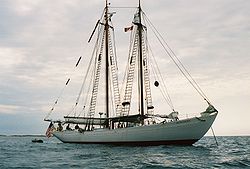Bowdoin (Arctic schooner)
| BOWDOIN (Arctic Exploration Schooner) | |
|---|---|
| U.S. National Register of Historic Places | |
| U.S. National Historic Landmark | |
|
Bowdoin at anchor off Sable Island, Nova Scotia
| |
| Location: | Castine, Maine |
| Coordinates: | 44°23′12″N 68°47′48″W / 44.38667°N 68.79667°WCoordinates: 44°23′12″N 68°47′48″W / 44.38667°N 68.79667°W |
| Built/Founded: | 1921 |
| Architect: | Hodgdon Brothers; Hand,William H.,Jr. |
| Governing body: | Private |
| Added to NRHP: | February 12, 1980[1] |
| Designated NHL: | December 20, 1989[2] |
| NRHP Reference#: | 80000411 |
The schooner Bowdoin /ˈboʊdɨn/ was designed by William H. Hand, Jr., and built in 1921, in East Boothbay, Maine, at the Hodgdon Brothers Shipyard now known as Hodgdon Yachts. She was designed for Arctic exploration, under the direction of Donald B. MacMillan, and has made 26 trips above the Arctic Circle in her life. She is currently owned by Maine Maritime Academy, located in Castine, Maine, and is used for their sail training curriculum.
The schooner's design and construction were carefully considered and well-executed, although neither was radical for their day. The vessel is unique today because of her specialized purpose - she is heavy and carries less sail for her displacement than most schooners because, in addition to the obvious ice hazards, the Arctic is known for having either no wind at all or too much.
The Bowdoin first crossed the Arctic Circle on August 23, 1921. A place unknown to most of the world, the Arctic had had few visitors from the South. Only sixteen years before, the goal of many generations of Arctic explorers had been reached when a northwest passage was traversed - a route which was, practically speaking, unusable, and after the construction of the Panama Canal, no longer necessary. Peary's North Pole expedition was merely a dozen years past. The last few Hudson's Bay and Davis Strait whalers had made their final trip home two years before.
The Bowdoin sailed north with Macmillan two dozen times, carrying scientists, adventurers and students.
On May 22, 1941 The United States Navy purchased Bowdoin from MacMillan for use in the war effort. Designated IX-50 she was placed in commission on 16 June 1941, with MacMillan in command.
Bowdoin was assigned to the South Greenland Patrol but did not report for duty at Ivigtut. The Greenland patrol existed for two major purposes: to assist in the defense of Greenland and to support the Army in its task of setting up air bases on Greenland as stopover and fueling points for aircraft being ferried to Great Britain. Bowdoin provided services in conjunction with air base site surveys and construction. That assignment lasted about 27 months. During that time, in October 1941, the two portions of the Greenland Patrol—the Northeast and Bowdoin's South—were combined into a single command, the Greenland Patrol, Task Group 24.8 which took its orders directly from the Commander in Chief, Atlantic Fleet. About two years after that event, on 23 October 1943, the auxiliary schooner was placed in reduced commission. On 16 December 1943, Bowdoin was placed out of commission at Quincy, Massachusetts. Her name was struck from the Navy list on 16 May 1944. She was sold as a hulk on 24 January 1945 through the Maritime Commission's War Shipping Administration—apparently to the Quincy Dry Dock & Yacht Corp., Quincy, Massachusetts.
Mystic Seaport acquired Bowdoin in 1959 and subsequently restored the ship.
It was declared the official sailing vessel of the state of Maine in 1986.[3][4] In 1989 Bowdoin was made a National Historic Landmark.[2][5]
In 1988 the Maine Maritime Academy took possession of Bowdoin. On July 30, 1991, again with students aboard, she came full circle, crossing the Arctic Circle once more. The Bowdoin was a part of the quest for understanding for decades and now, under the ownership of Maine Maritime Academy, she has turned to her own milieu, the North.
Specifications
- Length at waterline: 72'
- Length Over All: 88'
- Beam: 20'
- Draft: 10'
- Rig: Schooner
- Tons: 66 GRT
- Sparred Length: 100'
- Rig Height: 70'
Source
- This article includes text from the public domain Dictionary of American Naval Fighting Ships. The entry can be found here.
See also
References
- Virginia L. Thorndike: Arctic Schooner Bowdoin: A Biography (Paperback), 1995.
- ↑ "National Register Information System". National Register of Historic Places. National Park Service. 2007-01-23. http://www.nr.nps.gov/.
- ↑ 2.0 2.1 "HANCOCK (schooner)". National Historic Landmark summary listing. National Park Service. http://tps.cr.nps.gov/nhl/detail.cfm?ResourceId=1820&ResourceType=Structure. Retrieved 2008-05-14.
- ↑ The Arctic Schooner Bowdoin's History, Maine Maritime Academy, http://bowdoin.mma.edu/history.html, retrieved 2010-06-20
- ↑ The Schooner Bowdoin, Provincetown Banner, September 16, 2004, http://www.provincetownbanner.com/article/history_article/_/29590/History/9/16/2004, retrieved 2010-06-20
- ↑ James P. Delgado (June 30, 1989), National Register of Historic Places Registration: Bowdoin (Arctic Exploration Schooner) / USS Bowdoin (IX-50)PDF (32 KB), National Park Service and Accompanying seven photos, from 1924, 1988, and 1989PDF (32 KB)
External links
| Bowdoin (Arctic schooner)
]]
| ||||||||||
| |||||
- Pages using duplicate arguments in template calls
- Pages with broken file links
- Wikipedia articles incorporating text from the Dictionary of American Naval Fighting Ships
- Hancock County, Maine
- Schooners
- National Historic Landmarks in Maine
- Ships on the National Register of Historic Places
- Arctic exploration vessels
- United States Navy unclassified miscellaneous
- Ships built in Maine


